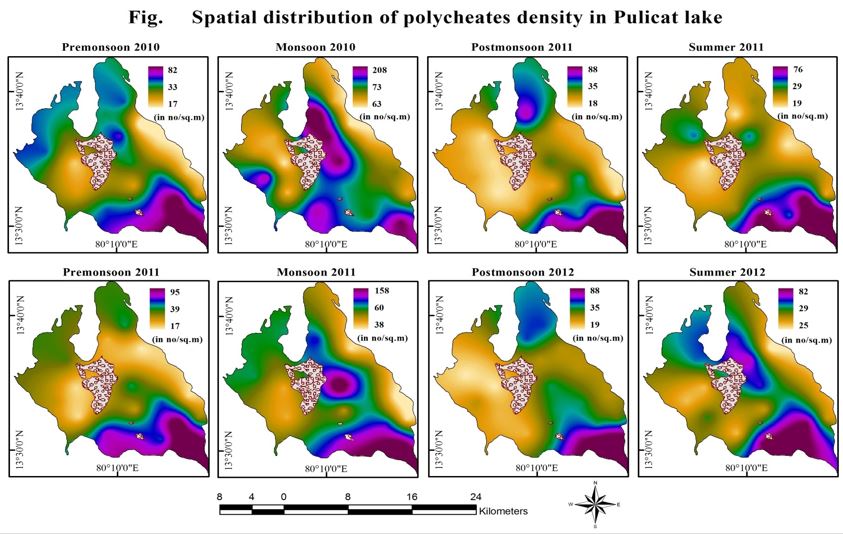Diversity of Polychaetes in Pulicat Lake
Totally ten species were identified. Heteromastus filiformis, Mediomastus capensis, Capitella capitata, Namalycastis siolii, Namanereis quadraticeps, Microneredies capensis, Unanereis macgregori, Marphysa graveli, Mystides angolansis Armandia longicudata, Among, three species namely Heteromastus filiformis, Mediomastus capensis, Capitella capitata, were recorded from family Capitellidae. Four species namely Namalycastis siolii, Namanereis quadraticeps, Microneredies capensis, Unanereis macgregori, from the family Nereidae. One species namely, Marphysa gravelyi, were recorded from family Eucinidae, Mystides angolansis from the family Phyllodocidae and Armandia longicudata, from the family Ophellidae. Among the ten species, two species namely Heteromastus filiformis and Armandia longicudata were found in all twenty stations. Mediomastus capensis represented in 10 stations. Capitella capitata and Namanereis quadraticeps represented in 8 stations. Marphysa gravelyi were found in seven stations. Namalycastis siolii were found in six stations. Microneredies capensis and Mystides angolansis were represented in two stations . Unanereis macgregori were found in only one station. Stations 1, 4, 5, 11, 12, 13, 14, 16 and 20 recorded with four species. St. 2, 7, 9, 10, 17, 18 were recorded with five species. St. 3, 6, 8 and 19 were observed with three species and St. 15 have six species.
 Among the ten species, the most dominant one was Armandia longicudata (43.38%) followed by Heteromastus filiformis(17.38%), Marphysa gravelyi (17.31%), Mediomastus capensis (5.84%), Namanereis quadraticeps(5.50%), Capitella capitata(4.55 %), Namalycastis siolii (4.14%), Mystides angolansis (1.09%), Microneredies capensis (0.48%) and Unanereis macgregori(0.34 %). The population density ranged from 17 no/sq.m to 208 no/sq.m and with mean population density of 58 no/sq.m. The diversity of polychaetes population varied from 1.96 to 2.456. Evenness of polychaetes differentiated from 0.79 to 0.99. Species richness deviated from 1.54 to 1.87. Hydrography, seaweeds and grasses cover, organic materials, nutrients, are the major factors influencing polychaetes density in Pulicat. Southern part of the lake had flourishing seaweeds and grasses and St.2 at Northern part of the lake found to be dominant of polychaetes where silt, organic carbon prevailed more during monsoon seasons.
Among the ten species, the most dominant one was Armandia longicudata (43.38%) followed by Heteromastus filiformis(17.38%), Marphysa gravelyi (17.31%), Mediomastus capensis (5.84%), Namanereis quadraticeps(5.50%), Capitella capitata(4.55 %), Namalycastis siolii (4.14%), Mystides angolansis (1.09%), Microneredies capensis (0.48%) and Unanereis macgregori(0.34 %). The population density ranged from 17 no/sq.m to 208 no/sq.m and with mean population density of 58 no/sq.m. The diversity of polychaetes population varied from 1.96 to 2.456. Evenness of polychaetes differentiated from 0.79 to 0.99. Species richness deviated from 1.54 to 1.87. Hydrography, seaweeds and grasses cover, organic materials, nutrients, are the major factors influencing polychaetes density in Pulicat. Southern part of the lake had flourishing seaweeds and grasses and St.2 at Northern part of the lake found to be dominant of polychaetes where silt, organic carbon prevailed more during monsoon seasons.
